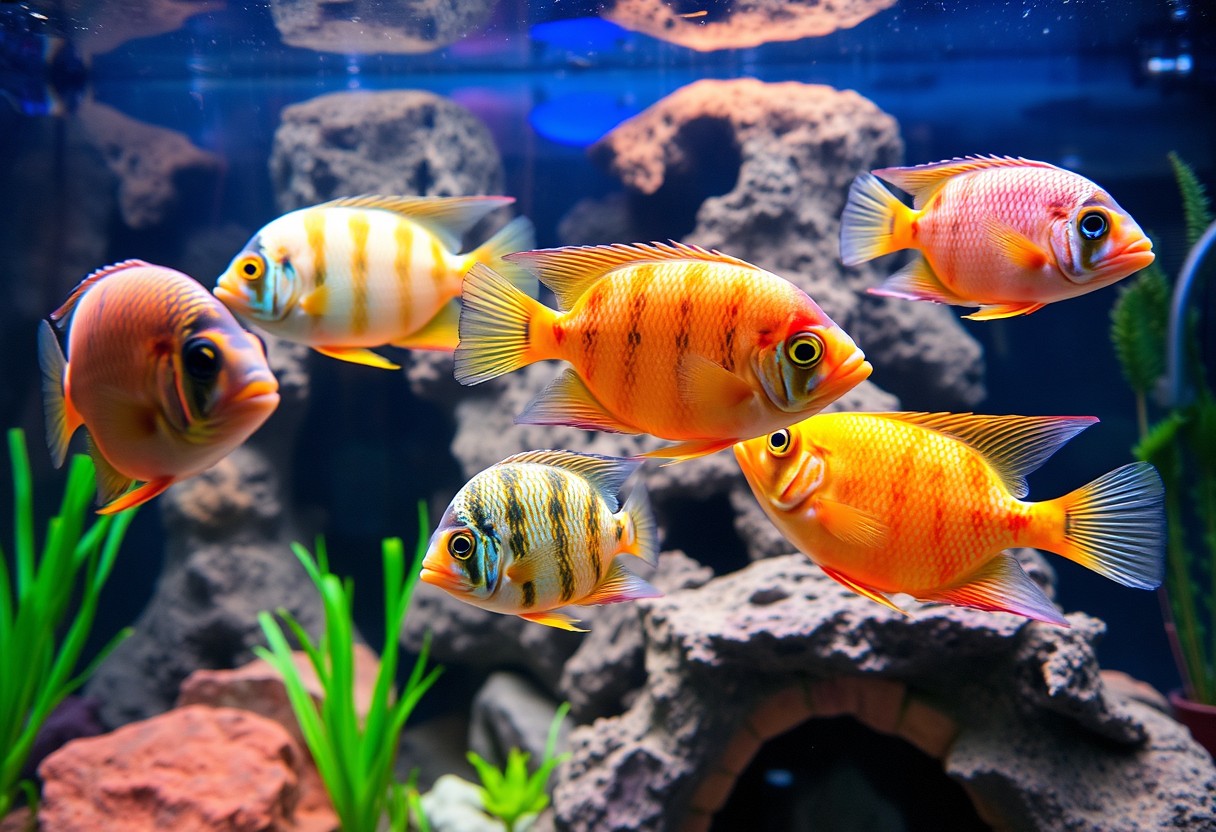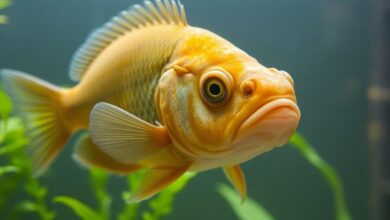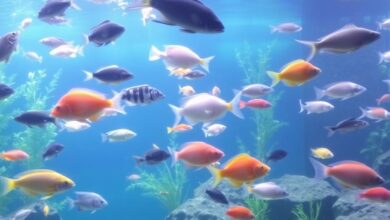
Cichlids are some of the most captivating fish in the aquarium trade, particularly the American species known for their vibrant colors and unique behaviors. If you’re considering adding these beautiful fish to your tank, knowing about the seven popular species and their expert care tips will help ensure a thriving environment. Understanding their specific needs can enhance your experience as an aquarium enthusiast while also fostering their health and well-being. Dive into this guide to learn how to provide the best care for your American cichlids.
Key Takeaways:
- Diverse Species: American cichlids encompass a wide range of species, each with unique characteristics and care needs, such as the Jaguar Cichlid and Honduran Cichlid.
- Water Conditions: Maintaining optimal water parameters, including temperature and pH levels, is necessary for the health of these fish, typically requiring warm, slightly acidic to neutral water.
- Tank Setup: Proper tank setup with ample hiding spots and territorial space is vital, as many American cichlids are territorial and thrive in environments that mimic their natural habitat.

Overview of American Cichlids
Your journey into the world of American cichlids opens up a vibrant array of colorful species, each showcasing distinct traits and behaviors. These freshwater fish thrive in diverse environments, making them popular choices for aquarists. From the majestic Oscar to the striking Jaguar cichlid, understanding their unique needs is crucial. As you explore the fascinating realm of American cichlids, you’ll find that they not only bring beauty to your aquarium but also require careful attention to ensure their health and well-being.
Characteristics of American Cichlids
Along with their stunning colors and patterns, American cichlids exhibit diverse personalities and complex social behaviors. They are known for their intelligence and adaptability, as well as their territorial nature. These traits can lead to fascinating interactions in tank settings, but it also means you need to consider compatibility when selecting tank mates.
Habitat and Natural Environment
Between rivers, lakes, and streams in North America, American cichlids have adapted to various habitats, which can include rocky areas, dense vegetation, and sandy beds. This diversity allows them to thrive in different environments while exhibiting unique traits based on their surroundings.
The natural habitat of American cichlids plays a significant role in shaping their behavior and health. In the wild, they prefer environments with ample shelter and hiding spots, such as rock formations and plant life. These areas provide protection from predators and breeding sites. For successful aquarium care, it is vital to replicate these conditions in your tank by incorporating similar substrates and decorations. This not only promotes their natural behaviors but also ensures a stress-free environment, leading to happier, healthier fish.
Popular Species of American Cichlids
Even among the diverse array of aquarium fish, American cichlids stand out for their vibrant colors and engaging personalities. Some of the most popular species include Angelfish, Jaguar Cichlids, Oscar Cichlids, Green Terror Cichlids, Convict Cichlids, Firemouth Cichlids, and Blue Acara. To care for these stunning fish, take a look at the Cichlid Family Care Sheet: Food, Tank Size, Compatibility to ensure you meet their specific needs.
Freshwater Angelfish
One of the most graceful species, the Freshwater Angelfish is adored for its elegant fins and variety of colors. These fish thrive in pairs or small groups and prefer a well-planted tank to feel secure and at home.
Jaguar Cichlid
Cichlid enthusiasts are often drawn to the Jaguar Cichlid for its stunning coloration and distinctive markings. This fish loves to dig and create hiding spots, requiring ample space and a well-maintained aquarium.
The Jaguar Cichlid is known for its striking black and gold patterns, which resemble a jaguar’s coat. As a semi-aggressive fish, they may display territorial behavior, especially during breeding. Ensure you provide a spacious tank with plenty of hiding spots to reduce potential conflicts.
Oscar Cichlid
The Oscar Cichlid is a favorite among fishkeepers due to its interactive personality and intelligent behavior. They often recognize their owners and can even learn tricks to receive food.
Further, Oscars are quite large and need a substantial tank of at least 55 gallons. With their vibrant colors and playful nature, they can be engaging pets, but their voracious appetite can lead to waste management challenges, so plan for regular maintenance and water changes.
Green Terror Cichlid
Above all, the Green Terror Cichlid is named for its vivid turquoise and green hues, making it a visual delight in any aquarium setting. This species is semi-aggressive and benefits from a spacious environment.
This fish flourishes in a well-planted tank with hiding spots to alleviate territorial disputes. Being particularly sensitive to water quality, it’s important to maintain clean and stable conditions to enhance their health and vibrant coloration.
Convict Cichlid
The Convict Cichlid is known for its stark black and white stripes, making it one of the most recognizable cichlids. This species is relatively hardy and can adapt well to various tank setups.
With their spirited temperament, Convict Cichlids can be aggressive when breeding, so it’s advisable to house them with compatible tank mates. They thrive in pairs and require ample space to establish territories, particularly during reproductive phases.
Firemouth Cichlid
Popular for their unique fiery red coloration on their throats, Firemouth Cichlids are a favorite for many aquarists. These fish are relatively peaceful but can display aggression when breeding.
Cichlids from this species appreciate caves and hiding spots in the aquarium, which they will use to establish territories. Offering a well-planted environment will help reduce stress, allowing them to thrive and display their beautiful colors.
Blue Acara
Cichlid lovers often enjoy the Blue Acara for its vibrant blue color and friendly disposition. They are relatively easy to care for and make an excellent addition to a community tank.
Acara fish adapt well to various water conditions, but they do prefer a well-filtered aquarium with plenty of swimming space. This adds to their lively personality as they explore their environment and interact with other species within the tank.
Tank Setup and Environment
Now that you’ve decided to keep American cichlids, setting up their tank environment is vital for their health and happiness. You’ll need to create a habitat that mimics their natural surroundings, ensuring it has enough space and appropriate conditions to thrive. By carefully considering factors such as tank size, water parameters, substrate, and decorations, you enable your fish to live in an enriching environment that promotes their wellbeing.
Ideal Tank Size
Behind each species of American cichlid is a specific space requirement that you should meet for optimal growth and behavior. Generally, a tank size of at least 75 gallons is advised to accommodate these fish, as they need ample room to swim, explore, and establish territories. Larger cichlids may require even more space, so consider the specific species you plan to keep.
Water Parameters
On maintaining your tank’s water parameters, focus on providing a stable environment for your cichlids. Keeping the water temperature between 75-82°F, pH levels around 6.5-8.0, and hardness between 5-20 dGH will help create a suitable habitat for your fish. Regular testing and adjustments of these parameters are necessary to prevent stress and illness.
Water quality plays a significant role in the health of your cichlids. Filtration is vital to remove waste and harmful toxins, while weekly water changes help maintain consistent parameters. Monitoring ammonia, nitrite, and nitrate levels is key, as high levels can lead to severe stress and health issues for your fish. Regular testing will ensure you keep the environment stable and safe.
Substrate and Decorations
About your tank’s substrate and decorations, you should choose materials that suits both the aesthetic and functional aspects of your cichlid habitat. A sandy or gravel substrate is preferable, as it allows for natural digging and sifting behavior. Additionally, include caves, rocks, and plants to provide hiding spots, territories, and enrichment for your fish.
Substrate can greatly enhance the living space for your cichlids. Ensure the substrate is smooth and non-toxic to prevent damage to their delicate bodies. Incorporating decorations, such as natural rocks and driftwood, not only creates an appealing environment but also encourages natural behaviors. Be mindful that some cichlids may rearrange decorations, so securing them appropriately will help maintain the desired layout.

Feeding and Nutrition
Keep your American cichlids healthy and vibrant by providing a balanced diet tailored to their specific needs. These fish thrive on a diverse menu, including high-quality pellets, frozen or live foods such as brine shrimp and bloodworms, and vegetable matter like spirulina. A well-rounded diet not only enhances their color but also supports their overall well-being. Aim to feed them twice a day, offering only what they can consume in a few minutes to avoid overfeeding and water quality issues.
Diet Essentials
One of the key components of a nutritious diet for American cichlids is quality protein. Incorporating high-protein foods is crucial for growth and maintenance. Additionally, including plant-based options will provide necessary vitamins and minerals that enhance their immune system. Take care to select a reputable brand of fish food specifically designed for cichlids, as this will ensure they receive the right balance of nutrients for their active lifestyles.
Feeding Techniques
Across the board, American cichlids can be picky eaters; therefore, it’s beneficial to vary their food options regularly. This not only keeps mealtime interesting but also helps to prevent nutritional deficiencies. Offer a mix of pellets, flakes, and occasional live or frozen treats to cater to their preferences. Monitor your fish’s behavior during feeding to ensure they’re eating appropriately, as this can also indicate their health status.
At feeding time, observe how your cichlids interact with different food types. Introduce new foods gradually, allowing them to adapt without stress. Additionally, it’s important to watch for competition among your fish; some may be more aggressive, which could hinder others from eating. Create feeding spots with decor to help manage aggressive behavior and ensure all your fish have the opportunity to feed without fear. Providing a stable feeding routine alongside varied, nutritious food options will support vibrant colors and overall vitality in your cichlids.
Behavior and Social Structure
Unlike many other fish, American cichlids display a complex range of behaviors and social hierarchies. They often exhibit a strong individual personality, which can lead to unique interactions within their tank. For a comprehensive understanding of these fascinating species, you can refer to cichlids.pdf.
Territoriality and Aggression
An important aspect of American cichlid behavior is their territoriality, particularly during breeding seasons. Males can become highly aggressive in defending their space, which may lead to conflicts with other fish. It’s imperative to provide adequate hiding spots and space to minimize aggressive encounters.
Compatibility with Other Fish
Beside their territorial nature, American cichlids can sometimes coexist with other species when properly matched. However, their aggressive tendencies can pose risks to more timid fish. Cichlids thrive well with tank mates that can hold their own, such as certain barbs or larger tetras.
Even when combining American cichlids with other fish, you should select companions wisely to avoid *stressful interactions*. It’s advisable to avoid small, slow-moving fish, as *they could become targets of aggression* from cichlids. Look for shyer species that can still handle competition, while ensuring an environment rich in *hiding spaces* for all fish. This balance will lead to a more harmonious community tank.

Expert Care Tips
Not only do American cichlids require proper tank conditions, but they also thrive with attentive care. To ensure the health and longevity of your fish, consider the following tips:
- Provide a well-maintained aquarium environment.
- Monitor water parameters regularly.
- Feed a varied diet appropriate for your species.
- Maintain a stable temperature.
- Provide adequate hiding spots and territories.
- Perform regular maintenance and water changes.
After learning these necessary care tips, check out this Top 10 Best Cichlid Species For Beginners for more insights.
Maintenance and Water Changes
Above all, maintaining a clean environment is vital for your American cichlids. Regular water changes of 20-30% every week will help keep the water quality high. Additionally, monitor your filtration system to ensure it operates effectively, as proper filtration aids in breaking down harmful chemicals.
Common Health Issues and Prevention
Below the surface, your cichlids may face health challenges that require prompt attention. Watch for signs of stress, such as abnormal swimming patterns or loss of appetite, which may indicate issues like ich or bacterial infections. Providing a stress-free environment can help prevent these problems.
For instance, an outbreak of ich can seriously impact your fish, leading to significant health declines. Ensure you maintain stable water conditions, as fluctuations can stress your fish and worsen susceptibility to diseases. Regularly check for signs of disease, and consider quarantining new fish to prevent infectious outbreaks. Consistent care, such as a balanced diet and a clean habitat, promotes a thriving aquarium.
Conclusion
Considering all points, selecting the right American cichlid species for your aquarium involves understanding their individual needs and behaviors. By following the expert care tips provided, you can create a thriving environment that promotes their health and happiness. Whether you choose the vibrant Convict or the majestic Jaguar, your dedication to their care will significantly enhance your aquatic experience. Embrace the journey of keeping these stunning fish, and you’ll be rewarded with a dynamic and colorful underwater world in your home.
FAQ
Q: What are the most popular species of American cichlids?
A: Some of the most popular species of American cichlids include the Jagged Cichlid (Parachromis managuensis), the Oscar (Astronotus ocellatus), the Blue Acara (Andinoacara pulcher), the Green Terror (Andinoacara rivulatus), the Firemouth Cichlid (Thorichthys meeki), the Red Devil Cichlid (Amphilophus labiatus), and the Convict Cichlid (Amatitlania nigrofasciata). Each species has distinct characteristics, colors, and care requirements, making them suitable for various aquarists based on their experience levels and tank parameters.
Q: What tank conditions do American cichlids require for optimal health?
A: American cichlids thrive in well-maintained aquariums with stable water parameters. A minimum tank size of 30 gallons is recommended, depending on the species. The ideal water temperature ranges from 75°F to 82°F, while the pH level should be between 6.5 and 8.0. It’s important to provide ample hiding spots using rocks, caves, and plants to reduce stress and territorial disputes. A filtration system is crucial for maintaining clean water, and regular water changes of 20-30% weekly are advised to keep the environment healthy.
Q: How can I manage aggression among my American cichlids?
A: Managing aggression in American cichlids involves several strategies. First, ensure your tank is spacious enough to provide territories for each fish. Incorporating plenty of hiding spots and visual barriers can reduce confrontations. It’s also beneficial to keep species that exhibit compatibility and grouping similar-sized fish together. Introducing new fish gradually can help establish a pecking order while minimizing stress. If aggression persists, consider separating the more aggressive individuals into a new tank to promote harmony among the others.





